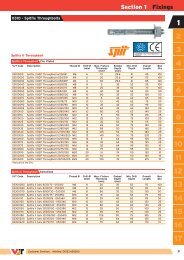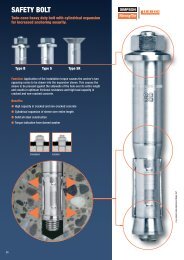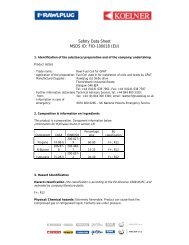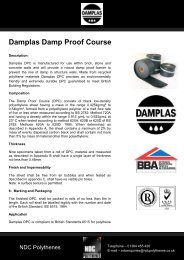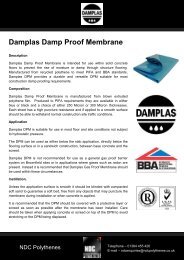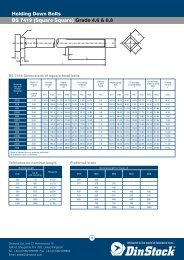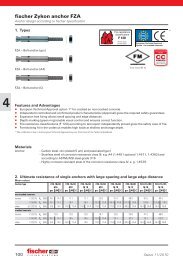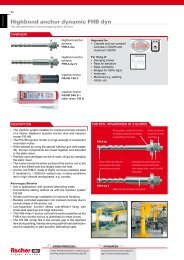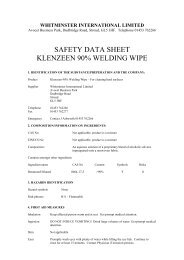UNIVERSAL SEALANTS (UK) LIMITED longterm
to download Safety datasheet - sdg.ie
to download Safety datasheet - sdg.ie
You also want an ePaper? Increase the reach of your titles
YUMPU automatically turns print PDFs into web optimized ePapers that Google loves.
Ref: HSD/F7<br />
Issue No: 5<br />
Date of Issue: 5 th December, 2003<br />
<strong>UNIVERSAL</strong> <strong>SEALANTS</strong> (<strong>UK</strong>) <strong>LIMITED</strong><br />
NUFINS DIVISION<br />
Kingston House, 3 Walton Road, Pattinson North,<br />
Washington, Tyne & Wear. NE38 8QA<br />
Telephone No: 0191 416 8360 Fax No: 0191 415 5966<br />
1. Product Identification<br />
Trade Name:<br />
Description:<br />
FORMSTRIKE MRO<br />
Blended hydrocarbon and fatty acid<br />
2. Composition / Information on Ingredients<br />
Ingredient CAS Number Conc. (w/w) Classification R. Phrases<br />
Petroleum Distillate 8008-20-6 60-80% F, Xn, N 10,22,38,52/53<br />
NOTE: Benzene (CAS No. 71-43-2) will normally be present in trace amounts but will always<br />
be less than 0.1% w/w marker level in the 21 st ATP to the Dangerous Substances Directive.<br />
This product is NOT CLASSIFIED as a carcinogen under the CHIP3 regulations.<br />
3. Hazard Identification<br />
Flammable, harmful by inhalation and may cause lung damage if swallowed. Irritating to eyes,<br />
respiratory system and skin. Harmful to aquatic organisms and has the potential to cause <strong>longterm</strong><br />
adverse effects in the aquatic environment.<br />
4. First Aid Measures<br />
Inhalation:<br />
In case of drowsiness or sickness remove to fresh air, keep patient warm and<br />
at rest. If unconscious, turn to the recovery position. Seek medical assistance.<br />
Skin Contact: Promptly remove contaminated clothing and wash the affected area with<br />
plenty of soap and water to ensure all traces of product are removed, then<br />
rinse thoroughly. Any contaminated clothing must be thoroughly cleaned<br />
before re-using. Seek medical advice if irritation persists.<br />
Eye Contact:<br />
Ingestion:<br />
Flush with copious amounts of clean water for at least 15 minutes, with the<br />
eye lids held open. Seek medical attention.<br />
Wash out mouth with water. Keep patient at rest and obtain medical attention.<br />
DO NOT INDUCE VOMITING.<br />
5. Fire Fighting Measures<br />
Suitable Extinguisher Media:<br />
Unsuitable Extinguishing Media:<br />
Exposure Hazards:<br />
Special Protective Equipment:<br />
Alcohol-resistant foam, dry powder, carbon dioxide or<br />
sand.<br />
Water jet.<br />
May give off toxic fumes if heated or involved in a fire,<br />
including carbon monoxide, carbon dioxide.<br />
Full face, positive pressure, self-contained breathing<br />
apparatus and full protective clothing.<br />
Page 1 of 5
Ref: HSD/F7<br />
Issue No: 5<br />
Date of Issue: 5 th December, 2003<br />
6. Accidental Release Measures<br />
Personal Precautions: Wear protective equipment as specified in Section 8.<br />
Do not eat, drink or smoke. Avoid contact with skin<br />
and eyes. Avoid breathing vapours. Eliminate all<br />
ignition sources.<br />
Environmental Precautions:<br />
Spillages:<br />
Eliminate all ignition sources. Keep people and<br />
animals away. Prevent entry into drains, sewers and<br />
watercourses. If spillage enters drains leading to<br />
sewerage works inform the local water company. If<br />
spillage enters rivers or watercourses inform the<br />
Environment Agency.<br />
Cordon off area. Avoid sparks and open flames.<br />
Absorb/contain spillage using inert absorbent<br />
granules, sand or earth. Transfer collected material to<br />
heavy-duty plastic/steel drums and keep in a well<br />
ventilated place for subsequent safe disposal. See<br />
Section 13.<br />
7. Handling and Storage<br />
Handling:<br />
Storage:<br />
No specific precautions required when handling<br />
unopened containers; follow any relevant manual<br />
handling guidance. Refer to Sections 6 and 8 if<br />
exposure to product is possible. Take precautionary<br />
measures against static discharges. Wash thoroughly<br />
with soap and water before eating, drinking or<br />
smoking, and after work<br />
Store in original containers in a well ventilated area<br />
away from heat, sunlight, ignition sources or open<br />
flame. Keep away from oxidising agents. Take<br />
precautionary measures against static discharges.<br />
8. Exposure Controls / Personal Protection<br />
Occupational Exposure Standards: Oil Mist – 8 hour TWA 5 mg/m 3 , 15 min STEL 10<br />
mg/m 3 (OES)<br />
Engineering Control Measures:<br />
Respiratory protection:<br />
Hand Protection:<br />
Refer to any applicable COSHH assessments.<br />
Engineering controls should be used where<br />
practicable in preference to personal protection and<br />
may include physical containment and good<br />
ventilation.<br />
If levels of vapour exceed the above limits use an<br />
approved respirator fitted with an appropriate gas<br />
cartridge (organic substance). All items must conform<br />
to EN149 and should be suitable for the levels of<br />
contamination present in the workplace.<br />
Wear Neoprene, Nitrile or PVC gloves or gauntlets.<br />
These must be manufactured to EN374. The material<br />
breakthrough time should be stated by the glove<br />
manufacturer, and must be observed at all times.<br />
Page 2 of 5
Ref: HSD/F7<br />
Issue No: 5<br />
Date of Issue: 5 th December, 2003<br />
Eye Protection:<br />
Body Protection:<br />
Foot Protection:<br />
Hygiene Measures:<br />
If splashing of the product is likely chemical resistant<br />
goggles conforming to BS 2092 should be worn.<br />
Wear suitable impervious, chemical resistant overalls.<br />
Wear chemical resistant safety footwear.<br />
Handle in accordance with good industrial hygiene<br />
and safety practice.<br />
9. Physical and Chemical Properties<br />
Appearance: Pale straw coloured Boiling Point: 150-270 o C<br />
liquid<br />
Odour: Slightly aromatic Vapour Pressure @ 20 o C: Approx. 200 pascals<br />
pH: N/A Evaporation Rate (Butyl Acetate = 1): N/D<br />
Flash Point: 46 o C Flammable Limits in Air: Upper: 6.0%<br />
Lower: 1.7%<br />
Solubility: Immiscible in water Autoignition Temperature: 225 o C<br />
Flammability:<br />
Flammable liquid<br />
Specific Gravity: 0.84<br />
10. Stability and Reactivity<br />
Stability:<br />
Materials to Avoid:<br />
Stable under normal conditions (see Section 7). Avoid<br />
heat, flames and sparks.<br />
Reacts strongly with oxidisers.<br />
Hazardous Decomposition Products: Thermal decomposition may lead to the formation of a<br />
wide range of compounds, some of which may be<br />
hazardous. With incomplete combustion smoke and<br />
hazardous fumes and gases, including carbon<br />
monoxide, may be formed.<br />
11. Toxicological Information<br />
There is no data available on the product itself.<br />
The following information is based on a knowledge of the components and the toxicology of<br />
similar products.<br />
Inhalation:<br />
Skin Contact:<br />
Eye Contact:<br />
Ingestion:<br />
Vapour concentrations above the recommended exposure levels are<br />
irritating to the eyes and respiratory tract, and may cause headaches,<br />
dizziness and have other CNS effects.<br />
Low order of toxicity. Frequent or prolonged contact may cause irritation<br />
and cause dermatitis.<br />
Irritating but does not cause tissue injury.<br />
Small amounts of liquid aspirated into the respiratory system during<br />
ingestion or from vomiting may cause bronchopneumonia or pulmonary<br />
oedema. Minimal toxicity.<br />
Page 3 of 5
Ref: HSD/F7<br />
Issue No: 5<br />
Date of Issue: 5 th December, 2003<br />
12. Ecological Information<br />
There is no data available on the product itself.<br />
The following information is based on a knowledge of the components and the toxicity of<br />
similar products.<br />
Mobility:<br />
Degradability:<br />
Bioaccumulation:<br />
Ecotoxicity:<br />
Floats on water. Partly evaporates from water or soil surfaces, but a<br />
significant proportion will remain after one day. Large volumes may<br />
penetrate soil and could contaminate groundwater.<br />
Biodegradable according to the appropriate OECD test. This product is<br />
expected to be removed in a wastewater treatment plant. Oxides rapidly<br />
by photochemical reactions in air.<br />
Not expected to bioaccumulate.<br />
Expected to be toxic to aquatic organisms.<br />
13. Disposal Considerations<br />
Dispose of unused product as hazardous waste, in accordance with all applicable local and<br />
national regulations, and in compliance with the Environmental Protection (Duty of Care)<br />
Regulations 1991.<br />
Used containers should be drained thoroughly. After draining, vent in a safe place away from<br />
sparks and fire. Residues may cause an explosion hazard. Do not puncture, cut or weld<br />
uncleaned drums.<br />
14. Transport Information<br />
UN Number: 1268 Packaging Group: III<br />
ROAD<br />
AIR<br />
ADR Class: 3 Air Transport Number: 3<br />
ADR Hazard Number: 30 Packaging Instruction: 310<br />
SEA<br />
IMDG Class: 3.3<br />
IMDG Page Number: 3375<br />
Marine Pollutant: P<br />
Proper Shipping Name: Petroleum Distillates, N.O.S. (contains Kerosene).<br />
15. Regulatory Information<br />
EU Classification and Labelling Particulars:<br />
Designated Name:<br />
Classification:<br />
FORMSTRIKE MRO<br />
Flammable, Harmful & Dangerous for the Environment<br />
Indication(s) of Danger:<br />
F, Xn & N<br />
Risk and Safety Phrases:<br />
R10: Flammable.<br />
R22: Harmful if swallowed.<br />
R38: Irritating to skin.<br />
R52/53: Harmful to aquatic organisms, may cause long-term adverse<br />
effects in the aquatic environment.<br />
Page 4 of 5
Ref: HSD/F7<br />
Issue No: 5<br />
Date of Issue: 5 th December, 2003<br />
S23: Do not breathe vapour/spray.<br />
S24/25:<br />
Avoid contact with skin and eyes.<br />
S61: Avoid release to the environment. Refer to special instructions<br />
/Safety Data Sheet.<br />
S62: If swallowed, do not induce vomiting. Seek medical advice<br />
immediately and show the container or label.<br />
<strong>UK</strong> Guidance Publications:<br />
<strong>UK</strong> Legislation:<br />
EH40; Occupational Exposure Limits, HSE. Revised annually.<br />
EH44; Dust in the Workplace: General Principles of Protection,<br />
HSE.<br />
EH26; Occupational Skin Diseases - Health and Safety<br />
Precautions, HSE.<br />
Health and Safety at Work, etc Act, 1974, and relevant<br />
Statutory Provisions.<br />
Control of Substances Hazardous to Health Regulations, 1999.<br />
The Manual Handling Operations Regulations, 1992.<br />
The Personal Protective Equipment at Work Regulations,<br />
1992.<br />
Chemicals (Hazard Information and Packaging for Supply)<br />
Regulations, 2002 - CHIP 3.<br />
16. Other Information<br />
Full Text of R-Phrases Referred to above:<br />
R10: Flammable.<br />
R22: Harmful if swallowed.<br />
R38: Irritating to skin.<br />
R52/53: Harmful to aquatic organisms, may cause long-term adverse<br />
effects in the aquatic environment.<br />
Training Advice:<br />
Recommended Uses:<br />
Further Information:<br />
Do not use unless trained to do so. Refer to the Technical<br />
Data Sheet for the product.<br />
For professional use only. This product is designed for use as<br />
a formwork release agent.<br />
This Safety Data Sheet was compiled in accordance with EU<br />
Directives 67/548/EEC and 1999/45/EC. Reference was also<br />
made to the above legislation and guidance publications.<br />
MSDS First Issued: 2 nd September, 1992<br />
MSDS Revised: 5 th December, 2003<br />
Changes in this Version:<br />
Prepared By:<br />
All sections revised to comply with CHIP 3 provisions.<br />
F. Stratton<br />
Disclaimer:<br />
The information in this document is offered for general health and safety<br />
guidance only and is not intended to be a definitive source of advice, nor does<br />
it constitute a risk assessment, for which the user is responsible. All<br />
information provided in this document is believed to be accurate to the best of<br />
our knowledge. Users of the products referred to should observe the<br />
recommendations, conditions and instructions relating to any relevant product<br />
label, usage information, consent or approval in force at the time. Further and<br />
more specific information may be obtained from the supplier on request.<br />
Page 5 of 5



